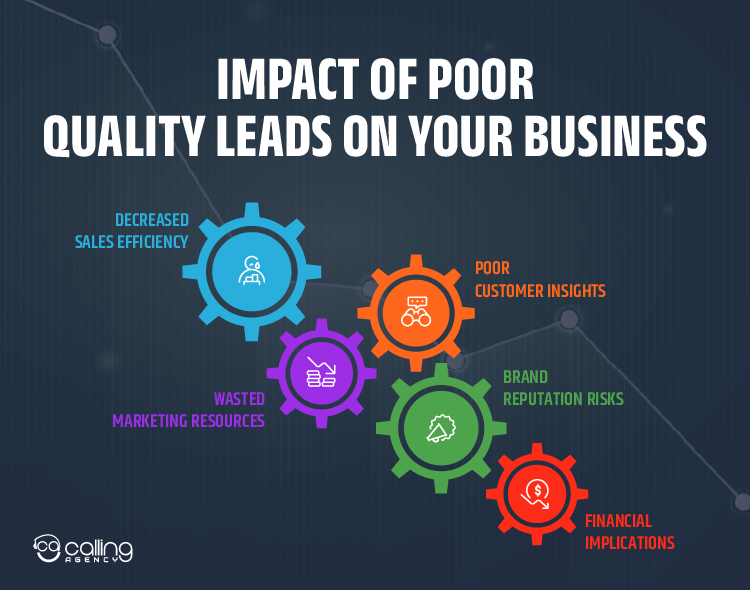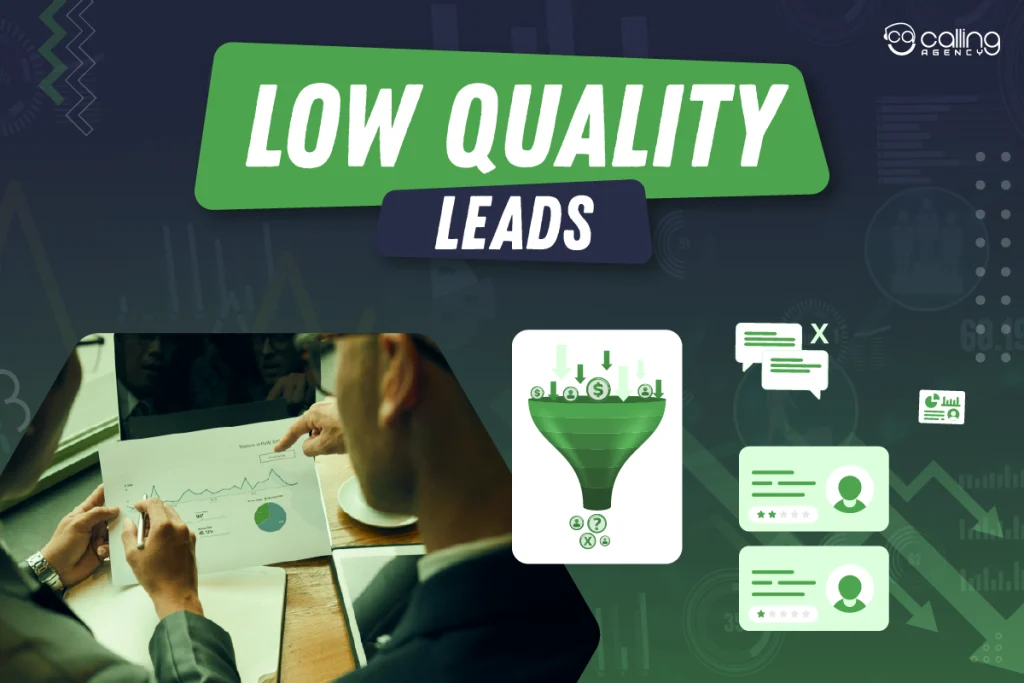In the world of sales, not all leads are created equally and distinguishing a good lead from a bad one can make or break your success. A low-quality lead is like a mirage in the desert of sales targets that are promising from a distance but disappear upon closer inspection.
Every moment spent pursuing a lead will drive your business forward. The quality of your leads has a direct impact on how you can allocate resources and whether your efforts can yield into tangible results for the betterment of your business.
A low-quality lead has very little possibility of converting into a paying customer. These leads are not interested in your product or service and do not fit your target audience profile and are just simply not ready to make a purchase yet.
What Are Poor-Quality Leads?
Why do poor-quality leads matter and how can they affect your bottom line? Stick around, and you’ll find out how to spot them and more importantly, how to avoid letting them clog up your sales pipeline.
If you are generating stacks of leads, but find out that they are not moving the needle on sales, it may be time to switch your focus from quantity to quality. It is one thing to generate leads, but if they are not a good match, they are not helping your business grow.
Low-quality leads also have downsides that ripple through your entire sales process. Not only do they waste time for your sales team, but they can also lead to misalignment between marketing and sales efforts and drain your marketing budget.
Low-quality leads are usually:
- Unengaged – Low-quality leads show little to no interest in your product or service. They might have signed up for a freebie but never interacted further.
- Misaligned- These leads do not align with your target customer profile. They might be outside your service area or in an industry that you do not cater to.
- Not Ready- These leads are just initiating their research and are not yet ready to make any purchasing decisions.
- Unqualified- These leads lack the budget or authority to make a purchasing decision. They do not meet the criteria for qualified leads and are unlikely to progress through the sales funnel.
Marketers often struggle with poor-quality leads due to the wide targeting. They are the ones that do not tick the box of your ideal customer profile. And also there might be a possibility that your product or service does not resonate their requirements.
Paid social media platforms make it easier to reach a large-scale audience, but that does not mean every person reached is valuable. Businesses often celebrate lead volume without looking at lead value. The truth is one hundred bad leads are worse than ten good ones!
Different techniques, like content marketing and targeted promotions can attract distinct types of leads. For example, offering an educational ebook might pull in high-intent leads looking to learn, while a discount promotion may attract those just seeking a deal.
Understanding Poor Quality Leads and Their Impact
The balance between lead quantity and lead quality is a fundamental consideration in any marketing and sales strategy. It directly affects your return on investment and overall business success. Some B2B companies make the mistake of prioritizing one over the other. But, in reality, it is extremely important to find the perfect balance between quality and quantity to achieve the best results in your sales pipeline.
Bad leads are prospects that will not convert into customers. They are the ones who, no matter how much time and effort you invest, just aren’t the right fit for your product or service.
Some common indicators of a bad lead are:
- Their business is the wrong size for your solution.
- They do not have the budget to pay for your product or service.
- They are not able to make purchasing decisions.
- They are not likely to buy from you in the near future.
- The prospect is uninterested in your sales attempts.
You will now be able to prevent your sales team from wasting their time and efforts and focus on dealing with qualified leads and producing a huge number of sales immediately.
Impact of Poor Quality Leads On Your Business
By knowing where your bad leads come from, you can make sure you are not investing precious demand budget in return for those leads. From wasted marketing budgets to a sales team bogged down chasing unqualified prospects, poor quality lead affects just about every aspect of your business.
Your leads are the fuel of your sales engine. If your team is working with poor-quality leads, they are wasting time chasing prospects who are just wasting your time, money and energy.
Hence, it is important that you know at the beginning, that what kind of leads are you having to deal with.

Decreased Sales Efficiency
Turning around an underperforming sales team will take a lot of effort, but it is far from impossible. You can set your team up for success by addressing the sales performance factors and understanding the key reasons for low sales.
You need to identify and take initiatives for issues like wasted sales resources, decreased conversion rates, lower sales team morale and misalignment between the sales and marketing teams. Fixing the flaw will make you achieve your desired goal.
The key is to act quickly and thoughtfully to build a sales engine that is efficient, motivated and primed for growth.
Wasted Marketing Resources
Low-quality leads come at a more cost-effective price and these leads are usually outdated and unverified. Every dollar spent on acquiring or nurturing poor-quality leads is a dollar that could have been invested in sharper targeting, more effective tools or a higher-value campaign.
Poor Customer Insights
Poor customer insights result in missed sales opportunities due to inaccurate data, distorted performance metrics, operational inefficiencies and unreliable forecasting. It will have a domino effect across your whole business, resulting in wasted marketing, a strained sales team, higher customer acquisition cost (CAC) and lower conversion rates throughout the funnel.
Brand Reputation Risks
It is easier to acquire new customers and retain existing customers when you have a strong brand. A poor reputation can harm your business. It is essential that companies manage their position in their chosen markets as well as their ability to achieve and exceed the expectations of customers, business partners and other third parties.
Reputational damage can lead to decreased revenue and increased employee turnover. It can also lead to a loss of confidence and trust from key stakeholders responsible for governance.
Financial Implications
Low-quality leads can result in lower overall profitability, which will hinder your ability to invest in better marketing and client service strategies. These hindrances can include changes in cash flow, revenue, investments and overall financial health.
Why Is It Important to Identify Poor Quality Leads?
Lead quality is determined by multiple factors like alignment with the Ideal Customer Profile (ICP), engagement level and readiness to purchase. Just as good-quality leads prove beneficial for the company, poor leads waste time and money.
Poor leads limit growth. If campaigns continue to target the wrong audience, businesses miss out on opportunities to connect with real prospects. This slows down expansion and gives competitors an advantage.
Identifying poor quality leads saves money early, saves time and improves growth.
How to Identify and Avoid Poor Quality Leads?
Sometimes businesses think that more leads equal to more sales. However, that is not necessarily the case.
It is essential to identify poor-quality leads to avoid wasting resources on unproductive efforts that do not contribute to your catch. Here’s the catch:
- Quantity over quality can lead to inefficiency.
- Not all interactions indicate a qualified lead.
- Initial interest doesn’t always translate to a ready-to-buy mindset.
Conclusion
A cleaner and effective pipeline starts with prioritizing quality. Low-quality leads may look good on paper but they cost your time, money and credibility
By defining what a quality lead looks like using frameworks like BANT, you can align your teams and ensure that valuable opportunities are prioritized. Ignoring lead quality can lead to spiralling costs with very little return.
Without a strong foundation of satisfied and long-term clients, it becomes more difficult to build a sustainable business.
FAQ
How Can I Improve Lead Quality?
By adopting different strategies, businesses can substantially improve the quality of the sales pipelines and the outcomes they generate. Some of the strategies include real-time data validation, lead scoring and qualification, routine data maintenance, predictive analysis and integrating quality at every touchpoint.
How Do I Know If My Lead Generation Strategy Is Working?
You will know if your lead generation strategy is working by tracking key performance indicators (KPIs) such a lead quality, conversion rates and customer acquisition cost (CAC) by integrating tools like CRM and analytics platforms.
What Are The Qualities That Make A Lead A Perfect Fit For A Business?
Although lead qualification can be challenging, it’s worth the effort to fine-tune your process. Some of the qualities that make a lead a perfect fit for a business are authority, awareness of the lead, sense of urgency, willingness to listen and alignment with your organization.
How Do High-Quality Leads Impact Your Business?
The cornerstone of this approach is lead generation. High-quality leads positively impact a business by increasing conversion rates and revenue, improving return on investment (ROI), fostering higher customer satisfaction and loyalty, and making the sales and marketing processes more efficient.
Why Is Lead Quality Important In Marketing Strategies?
Without lead generation, you business will be dead in a short period of time. Lead generation is important in marketing strategies because it will expand your market, generate better business opportunities, improve your lead quality, better engagement, boost conversions, raise your revenue and improve your brand recognition.
What Strategies Can Increase Lead Quality?
To increase lead quality, you need to define your Ideal Customer Profile, optimize lead generation channels and content for high-intent visitors, enhance landing pages, use marketing and sales data to refine targeting and implement a lead nurturing program with personalized content.






